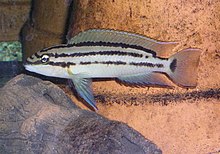
Cichlids are fish from the family Cichlidae in the order Cichliformes. Traditionally Cichlids were classed in a suborder, the Labroidei, along with the wrasses (Labridae), in the order Perciformes, but molecular studies have contradicted this grouping. On the basis of fossil evidence, it first appeared in Tanzania during the Eocene epoch, about 46–45 million years ago; however, molecular clock estimates have placed the family's origin as far back as 67 million years ago, during the late Cretaceous period. The closest living relative of cichlids is probably the convict blenny, and both families are classified in the 5th edition of Fishes of the World as the two families in the Cichliformes, part of the subseries Ovalentaria. This family is large, diverse, and widely dispersed. At least 1,650 species have been scientifically described, making it one of the largest vertebrate families. New species are discovered annually, and many species remain undescribed. The actual number of species is therefore unknown, with estimates varying between 2,000 and 3,000.

Lake Tanganyika is an African Great Lake. It is the second-oldest freshwater lake in the world, the second-largest by volume, and the second deepest, in all cases after Lake Baikal in Siberia. It is the world's longest freshwater lake. The lake is shared among four countries—Tanzania, the Democratic Republic of the Congo, Burundi, and Zambia—with Tanzania (46%) and the DRC (40%) possessing the majority of the lake. It drains into the Congo River system and ultimately into the Atlantic Ocean.

The terms shell dwellers or shelldwellers, shell-breeding, or ostracophil are descriptive terms for cichlid fish that use the empty shells of aquatic snails as sites for breeding and shelter. The terms have no taxonomic basis, although most shell-dwelling cichlids are from Lake Tanganyikas lamprologine lineage. Many shell dwelling cichlids are popular with fishkeepings and are frequently kept in aquaria.

Tropheus moorii is a species of cichlid endemic to Lake Tanganyika in Africa. Over 40 different color morphs of this species are dispersed throughout the lake, ranging from dark green to flame red and yellow. They mostly feed on filamentous algae on the rocky shallows they inhabit. T. moorii is a maternal mouthbrooder, so eggs are fertilized and young are carried in the mouth of the female while they hatch and develop.

Chalinochromis is a small cichlid genus from the subfamily Pseudocrenilabrinae. These ray-finned fishes are endemic to Lake Tanganyika in the East African Rift. The scientific name refers to the bridle-like markings across the heads of members of this genus. They have specialized jaws enabling them to feed on sponges.

Variabilichromis moorii has no common name and is a species of freshwater cichlid endemic to Lake Tanganyika in eastern Africa. It is a small ovate bodied fish named for an early collector of fish from the lake, John Edmund Sharrock Moore (1870-1947) who was a cytologist, zoologist and led an expedition to Lake Tanganyika and who discovered this species. Juveniles are usually yellow, and adults are dark brown to black in color. It reaches a total length (TL) of 10.3 centimetres (4.1 in). Currently it is the only member of its genus. V. moorii feeds on algae, zooplankton, and benthic invertebrates. It is also found in the aquarium trade.
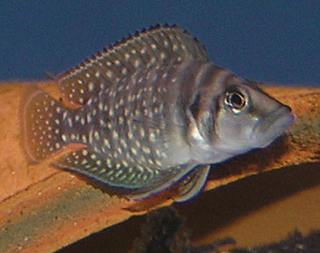
Altolamprologus is a small genus of pseudocrenilabrine cichlids endemic to Lake Tanganyika in eastern Africa. They inhabit areas of the lake with large amounts of rock, most frequently in water two to ten metres in depth. Two formally described species comprise this genus, with perhaps one dwarf A. compressiceps-like species being considered an undescribed species by some.

Neolamprologus is a genus of cichlids endemic to eastern Africa with all but one species, Neolamprologus devosi from the Malagarasi River, occurring in Lake Tanganyika. It is the largest genus of cichlids in Lake Tanganyika and also the largest genus in the tribe Lamprologini, which includes Altolamprologus, Chalinochromis, Julidochromis, Lamprologus, Lepidiolamprologus, Telmatochromis and Variabilichromis. The latter is a monotypic genus doubtfully distinct from Neolamprologus.
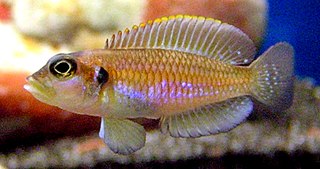
Lamprologus ocellatus is a species of shell dwelling cichlid endemic to Lake Tanganyika. It is a popular aquarium fish due to its small size, appearance, and intelligence.
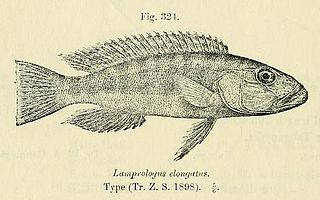
Lepidiolamprologus is a small genus of cichlids endemic to Lake Tanganyika in eastern Africa. It is closely related to Altolamprologus. and there is the possibility that a revision of the genus could see more species added.

Telmatochromis is a small cichlid genus of the subfamily Pseudocrenilabrinae. These ray-finned fishes are endemic to the Lake Tanganyika basin in Africa.

Amatitlania sajica, the T-bar cichlid or Sajica cichlid, is a Central American species of cichlid found in freshwater streams and lakes on the Pacific slope of Costa Rica. The fish is tan colored with seven indistinct bars on the body. The third bar is usually prominent and coupled with a dark lateral stripe running from the gill cover results in a horizontal T-shaped mark, hence the common name of T-bar cichlid.

Julidochromis marlieri is a species of cichlid endemic to Lake Tanganyika where it is only known from the northwestern portion preferring rocky shorelines in deep waters. In the aquarium trade, it is commonly known as Marlier's Julie, Spotted Julie or Chequered Julie. This species reaches a length of 15 centimetres (5.9 in) TL. Adult females are larger than adult males.
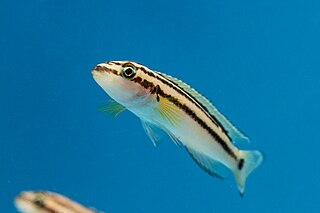
The golden julie is a species of cichlid endemic to Lake Tanganyika, being found only in the extreme northern and southern shorelines of the lake in rocky environs. This species reaches a length of 8.5 centimetres (3.3 in) TL.

The convict julie is a cichlid species in the subfamily Pseudocrenilabrinae family endemic to Lake Tanganyika. Hence it is found in Burundi, the Democratic Republic of the Congo, Tanzania, and Zambia. The fish is named after Charles Tate Regan.

Neolamprologus pulcher is a species of cichlid endemic to Lake Tanganyika where it prefers locations with plenty of sedimentation. The common names for N. pulcher include daffodil cichlid, fairy cichlid, princess of Zambia and lyretail cichlid. This species can reach a length of 10 centimetres (3.9 in) TL. It can also be found in the aquarium trade.

Lamprologini is a tribe of African cichlid fishes. It contains seven genera and nearly 100 species. Over half of the species in this tribe are in the large genus Neolamprologus. Most genera in the tribe are endemic to Lake Tanganyika, but one species of Neolamprologus is from the Malagarasi River in Tanzania, and several species of Lamprologus are from the Congo River Basin.

Hemichromis letourneuxi is a species of cichlid which is native to West Africa and is popular in the aquarium hobby and it has been introduced to the Caribbean and the south-east United States where it is invasive.

Julidochromis marksmithi is a species of cichlid from the tribe Lamprologini of the subfamily Pseudocrenilabrinae which is endemic to Lake Tanganyika where it occurs on the Tanzanian shore around Kiplipi in Nkasi District.
Telmatochromis brichardi is a species of cichlid from the tribe Lamprologini, part of the subfamily Pseudocrenilabrinae, endemic to Lake Tanganyika. It feeds on algae in rocky habitat. It is a cavity nester which forms temporary pairs for breeding, in which the male defends the territory and the female tends the brood. The specific name honours the aquarium fish dealer Pierre Brichard (1921-1990).






